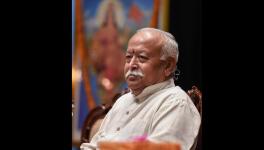The Politics of Seizing ‘Life-Cycle’ of Cows
Image for representational use only; Image Courtesy : abc.net.au
In a bid to prove themselves as better Hindus, the Congress’s soft Hindutva is becoming more visible in Madhya Pradesh than any other state. On January 17, Bhopal Mayor Alok Sharma said, “The municipal corporation wants to prepare a cow cremation centre for their salvation. We will do it as soon as we find a suitable land for it."
Sharma said that the project was already under discussion under the former Chief Minister Shivraj Singh Chauhan’s regime and the new regime plans to take it forward. The city’s municipal authorities are already on the lookout for a site for the purpose.
Congress to Further the ‘Cow Narrative’
As mentioned in their election manifesto for Madhya Pradesh, an increase in grants for cow welfare and better facilities for stray cows were mentioned.
On January 11, directives were given for the campaign to solve the stray cattle menace in the state. The campaign which aims at capturing stray cattle to rehabilitate them, while initially keeping them in cow shelters, began on January 16 in Bhopal. The government targets rehabilitating around 5,000 stray cattle in the city.
The inter-departmental meeting where the decision was taken was held under the chairmanship of animal husbandry, fisherman welfare and fisheries development minister Lakhan Singh Yadav. He said he would inspect the areas between January 22 and 25 to take stock of the stray cattle menace.
The government also plans to make one cowshed for every 6 panchayats, while stray cattle in the state are being given UID tags. It was also reported in the meeting that 4.37 lakh stray cattle including 1.53 lakh ‘gauvansh’ (cows) are free on the streets. Out of the 1,285 registered cow-shelters, 614 are functional. However, according to an estimate by the animal husbandry department in 2018, there are around 6 lakh stray cattle in the state.
Economic Cost of fallen cattle
As per a 2016 report in The Economic Times, the hide of a fallen cattle fetches between Rs. 500 to Rs. 800, the carrion (fresh meat) sells at around Rs. 40 per kg, the dried strips of carrion (flesh) sells at around Rs. 100 per kg, bones fetch Rs. 10 per kg and the fat fetches Rs. 20 per kg.
A “Bham” which is comprised of a few families, bids for the clearance of dead animals with the local panjrapoles (a reserve where old or sick animals are kept). Typically, each bham manages to get about six to seven dead animals a day leading to about Rs. 10,000 to Rs. 12,000 monthly income for everyone involved.
However, the cremating of fallen cattle will draw nothing but hostility towards the minority communities of Dalits and Muslims by stealing their employment. While furthering Congress’s soft Hindutva, the creation of a crematorium goes against India’s custom of burying its’ fallen animals. Even though, very evidently, animals do not have a religion; our politicians, it seems, will take more time to accept that.
Hostile Perversion of Tradition
Prof Harish Narang (Retired Head of Department, Centre for English Studies, JNU), while speaking with NewsClick said, “This is a gimmickry. Traditionally, the Dalit communities have taken care of the dead carcasses, which also means employment for them. However, in the past five years, there have been many instances where those taking even the dead carcasses have been beaten up, and some killed. Even NGOs who used to help in removing carcasses, are scared of the ‘gaurakshak’ brigade. The crores of grants that have been given to build cow shelters, have been consumed by the so-called cow protectors. On the other hand, the cows in shelters are suffering due to various conditions. The central government is responsible for the current situation of cattle in the country.”
After the cattle slaughter ban and the ban of selling of cows for slaughtering, which itself has disturbed the natural order of things and made trade a tough task, the cattle owners have been faced with another formula.
In November 2017, the Madhya Pradesh government had proposed a law that made the abandonment of cows an offence and punishable under the Indian Penal Code. The law was further recommended by Swami Akhileshwaranand, chairman of the executive council of the Madhya Pradesh Cow Protection Board.
Cattle which has been an essential economic asset for the Indian poor, and treated by farmers as insurance against crop failures has been losing any productive value for cattle rearing and has become the “holy tool” for Hindutva politics.
“Instead of this gimmickry of a crematorium, we need a policy on how to dispose of dead carcasses. In this country, where there’s not enough facilities for humans, we are going to build a crematorium. The Congress government should make a policy encouraging the communities, who had been taking care of the dead cattle and ensure that these communities should not be victimised by the so called ‘gaurakshaks’. They should restore the traditional rights of Dalit communities and Muslims for whom this was a way of earning money,” Prof Narang further added.
Get the latest reports & analysis with people's perspective on Protests, movements & deep analytical videos, discussions of the current affairs in your Telegram app. Subscribe to NewsClick's Telegram channel & get Real-Time updates on stories, as they get published on our website.























